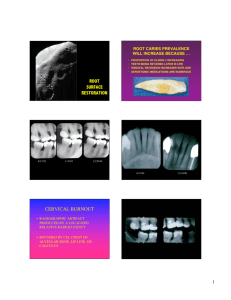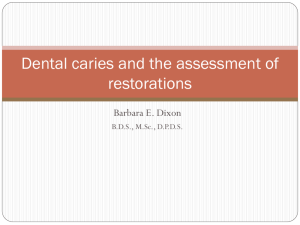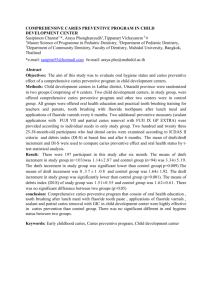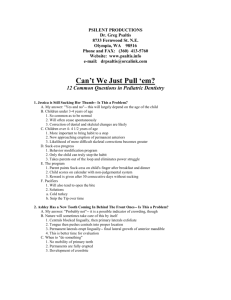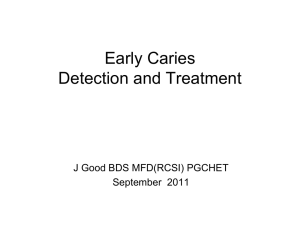cons 9
advertisement
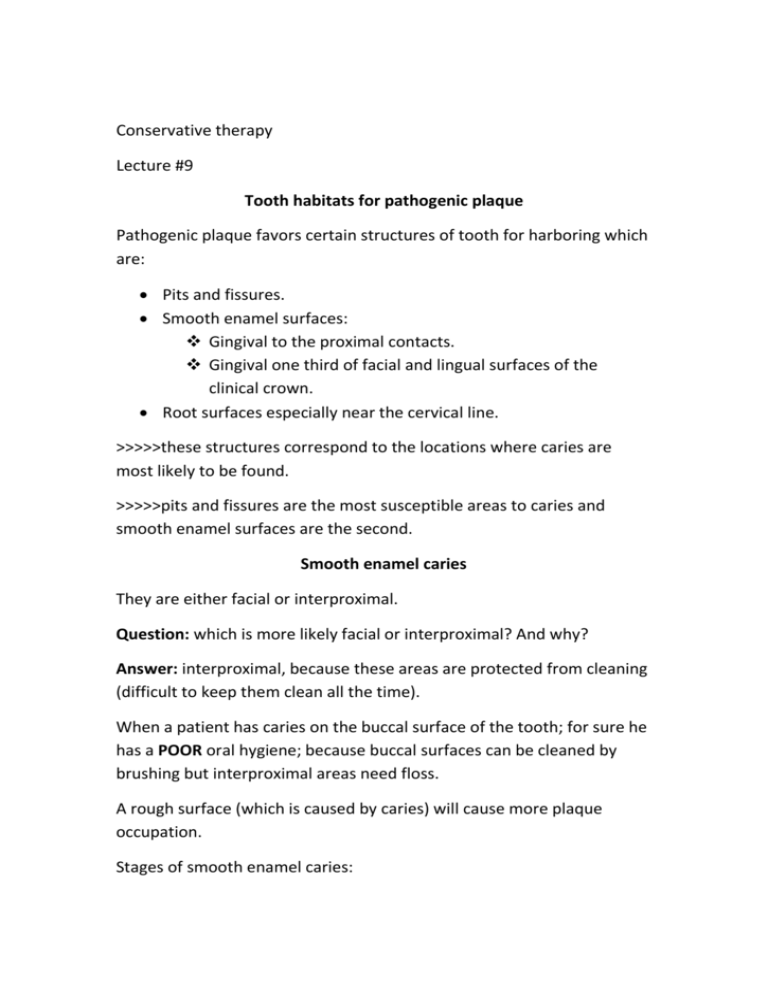
Conservative therapy Lecture #9 Tooth habitats for pathogenic plaque Pathogenic plaque favors certain structures of tooth for harboring which are: Pits and fissures. Smooth enamel surfaces: Gingival to the proximal contacts. Gingival one third of facial and lingual surfaces of the clinical crown. Root surfaces especially near the cervical line. >>>>>these structures correspond to the locations where caries are most likely to be found. >>>>>pits and fissures are the most susceptible areas to caries and smooth enamel surfaces are the second. Smooth enamel caries They are either facial or interproximal. Question: which is more likely facial or interproximal? And why? Answer: interproximal, because these areas are protected from cleaning (difficult to keep them clean all the time). When a patient has caries on the buccal surface of the tooth; for sure he has a POOR oral hygiene; because buccal surfaces can be cleaned by brushing but interproximal areas need floss. A rough surface (which is caused by caries) will cause more plaque occupation. Stages of smooth enamel caries: 1st: incipient lesion. 2nd: cavitations. When the cavitations happen, you can notice the facial caries but the proximal caries are difficult to detect in the incipient phase. Proximal caries CAN'T be detected by vision or by dental explorer . >>>>>soooooo the best diagnostic tools to detect the proximal caries are the RADIOGRAPHS in the incipient phase. >>>>>as the dr. said before (in the last lecture) in the pits and fissures caries we detect them in the incipient phase by passing the probe on the fissures but we should be careful because they may be converted from incipient lesion to cavitation and not always the probe should stick in the fissure if there is caries but sometimes the structure of the fissure is what causing the probe to stick in it>>>> y3ni: mo kol al-fissures carious eza be3ale8 fehom al-probe. Clinically, progression of caries in the same tooth is different, some sides are more carious and progressed than other sides. For example in class V lesion we have combination of cavitation and demineralization or sclerosis so we are able to see more than one of these in one cavity. Root caries From the name we indicate that they are caries on the root. The most bacteria that cause this kind of caries are actinomyces species. >>>>>factors that facilitate root caries: 1. Gingival recession) ;(انكشافgingiva should be exposed to have root caries. Question: could “over eruption” be a factor? Answer: noooooooo; because over eruption makes compensation of the pulp more than exposure the root. So recession will be more active. 2. Poor oral hygiene; specially in old patient because they are less motivated and have lowered digital dexterity()مهارة اسخدام االصابع 3. Anatomic surface contours; difficulty in oral hygiene because of concavities and others those are hard to clean. >>>>>why root caries is alarming???????????? Because of: Very rapid progression. Often asymptomatic; because of combination of sclerosis and secondary dentine so thicker dentine will be formed. Closer to the pulp. Difficult to restore. Note>>>>> secondary dentine is formed throughout life and tertiary dentine is formed in respond to stimuli like; caries and high occlusion forces. Incipient lesion It appears as “white spot lesion”. In the picture (in the handout) there is white band or line on the buccal surface of the lower 1st molar. This is for sure incipient lesion. Question: why does it appear whiter than the rest of the tooth? Answer: because in the incipient lesion there is demineralization but there is no cavitation and movement of the ions or the mineral phase of the crystal outside the tooth structure will be displaced by voids (empty spaces) filled by air that look whiter in color than the rest of the tooth and this is very important to diagnose the incipient lesion. Question: how do we diagnose the incipient lesion? Answer: it should be dry to appear white because it’s filled by air but when it’s wet it will be almost like the same color of the tooth structure because it’s filled by liquid (water). So we should put the air syringe on the tooth and pull the water to see the lesion clearly. WE CAN’T SEE THE INCIPIENT LESION WHEN IT’S WET. >>>>> this is a characteristic feature of the incipient lesion. Question: does the incipient lesion affect the sensitivity of the tooth ( y3ne eno hal btzeed 7asaseyt el asnan la el a$ya2 el bardeh ao el sa5neh)? Answer: no because the incipient lesion is not invasive; it just appears on the enamel. There are two phases when the caries are invasive and painful: 1. 2. When they reach DEJ. When they reach the pulp. Soooo when the caries on the enamel or in the middle of the dentine; there will be no pain. Cavitation Cavitation of the surface occurs when the subsurface demineralization is so extensive that the tooth structure surface collapses. Once we have cavitation; it’s no longer reversible. We can’t restore the tooth back to its normal composition. Question: when do we (as dentists) leave caries by intention? Answer: of course we shouldn’t because residual caries give rise to recurrent caries. But there is a technique in the British school called “indirect pulp capping” says when the caries are so deep and reach the pulp; we should remove all the caries but the deepest layer of the caries which is the one above the pulp; we put a restorative material above it and every 45 days we remove it and put a permanent filling. This will induce the formation of secondary dentine. This technique is not used nowadays because pain may persist. On the other hand, in the American school, since the caries have reached the pulp, we do root canal treatment for the tooth. When the tooth surface becomes cavitated, it allows filamentous bacteria “lactobacilli” to become established in the cavitated lesion which was aroused first from mutans. In the incipient lesion there are no bacteria but if we take a smear of plaque above the incipient lesion we will found lots of streptococcus. Diagnosis We should be careful with the explorer. To diagnose smooth surface caries especially the proximal smooth surface caries; we use radiographs (x-rays) mainly. Always the radiographs are underestimating the caries. Once we see a lesion on the tooth; it will be mostly more advanced than on the radiograph. >>>>>Explanation for the previous two points: When we see the lesion on the radiograph; we see it like a cone and this cone may reach to half of the dentine on the radiograph BUT if we take a histological cross section: we will see the cone almost has been reached DEJ. OR when caries on the radiograph has been reached DEJ, histologically it will be beyond DEJ ( y3ne aktar o btwasl la 1mm inside the dentine). Noncavitated enamel lesions retain most of the original crystalline framework of the enamel rods and the etched crystallites serve as nucleating agents for remineralilzation. >>>>> it means that if we want to retain the minerals, we should have scaffolds or net work because we want to retain the minerals to the crystals in an organized way. That’s why cavitation is irreversible because we lose this net work or scaffolds and ions will replace them. The supersaturation is the driving force of the ions towards the tooth structure. If a patient has an incipient lesion and we improve the oral environment by oral hygiene or by chloride, this incipient lesion will be turned into arrested lesion. In the handout pg 4 slide 2: this th tooth is lower 5 (distal) and because the lower 6th is extracted so it’s easy to clean the lesion. Arrested lesion can be observed clinically by: >>>COLOR: arrested lesion is brown (it’s darker than the incipient because entry of ions with stains from the oral environment) but the incipient is white. >>>HARDNESS: arrested is even harder than the enamel. Always there is balance between demineralization and reminerlization but when there is a big loss of minerals, there will be lots of uptake of fluoride (that’s why it’s harder). Zones of incipient enamel lesion Histologically, there are four zones from the deepest to the most superficial: 1. Translucent zone: is the deepest zone and representing the advancing front of the enamel lesion. Its name refers to its structureless appearance when perfused with quinoline solution and examined with polarized light. Structureless>>more demineralization>>spaces>>gives full dyeing material (quinoline dye) under polarized light>>translucent appearance. In this zone, the spaces because of more demineralization and the ease of hydrogen ion penetration. Bacteria metabolism at the surface gives acids and the acids make demineralization and bacterial byproducts such as hydrogen ions do the penetration as long as the place that was filled with minerals is now empty and is a space. The total pore volume is 1%. 2. Dark zone: is the 2nd zone where remineralization phase is taking place because as we said before caries is an active process where re- and demineralization are taking place. This zone was translucent before and it has many pores but because of reminerlization; it will appear dark. Total pore volume is 2% to 4% ( y3ne aktar mn el translucent becoz el dark feha pores ktaaaar bs z3’aaar(zy b3d elnas) ama bl translucent 3dadhom 8leel bs kbaaar( this sheet is dedicated to Dema Khraisat). Body of the lesion: is the largest portion of the incipient lesion while in a demineralizing phase. It has the largest pore volume varying from 5% at the periphery to 25% at the center. There are mineral dissolution along these areas of relatively higher porosity. 3. Surface zone: the last zone and it’s unaffected (no change). It has lower pore volume than the body of the lesion (less than 5%) and radiopacity comparable to unaffected adjacent enamel. Also it has the greatest fluoride concentration. There are 2 reasons why demineralization happens at the subsurface not at the surface directly: 1. High fluoride conc. at the surface will make adjacent subsurface less acids resistance and more demineralization. 2. ph>> 4.5 makes roughening and 3 to 4 make cavitation as going down in surfaces. *** the intact surface is very important bcoz it makes the caries reversible but if there is no intact surface it’s irreversible. That’s why we should be careful by using the explorer to avoid destroying the intact surface in the incipient lesion. Zones of dentinal caries Progression is different than the enamel. Starting from the pulp to the turbid layer: 1. zone 1: normal dentine; >no crystals in the lumen. >no bacteria in the tubules. >normal composition and morphology. 2. zone 2: subtransparent dentine; >demineralization happens in the inter-tubular dentin (ma bain el tubules). >initial formation of fine crystals in the tubule lumen by the advancing front>>always when there is demineralization, remineralization exists (balance). Why does not demineralization happen inside tubule? Bcoz the more important is inside the tubule so we don’t want to make the tubules open>> this is a defense mechanism. >damage to the odontoblastic processes. >no bacteria found. 3. zone 3: transparent dentin; >softer than normal dentin. >further loss of inter-tubular dentin and many large crystals in the lumen of the tubules. >no bacterial penetration. >collagen cross linking is still intact bcoz of remineralization. No collagen>no remineralization>irreversible phase. 4.zone 4: turbid dentin; >it’s called turbid bcoz of bacteria. >widening and distortion of dentinal tubules. >little mineral present. >collagen is irreversibly denatured. >not capable of self repair. 5.zone 5: infected dentin; >5arbaaaaaaaan >decomposed dentin with no structures >huge no. of bacteria. >should be completely removed in the cavity preparation. The infected dentin zones are turbid and infected The affected dentin zones are subtransparent and transparent and they still hard. The last two slides were read by the doctor with no extra notes. Corrections are welcomed DONE BY: Safa’a al-amr
